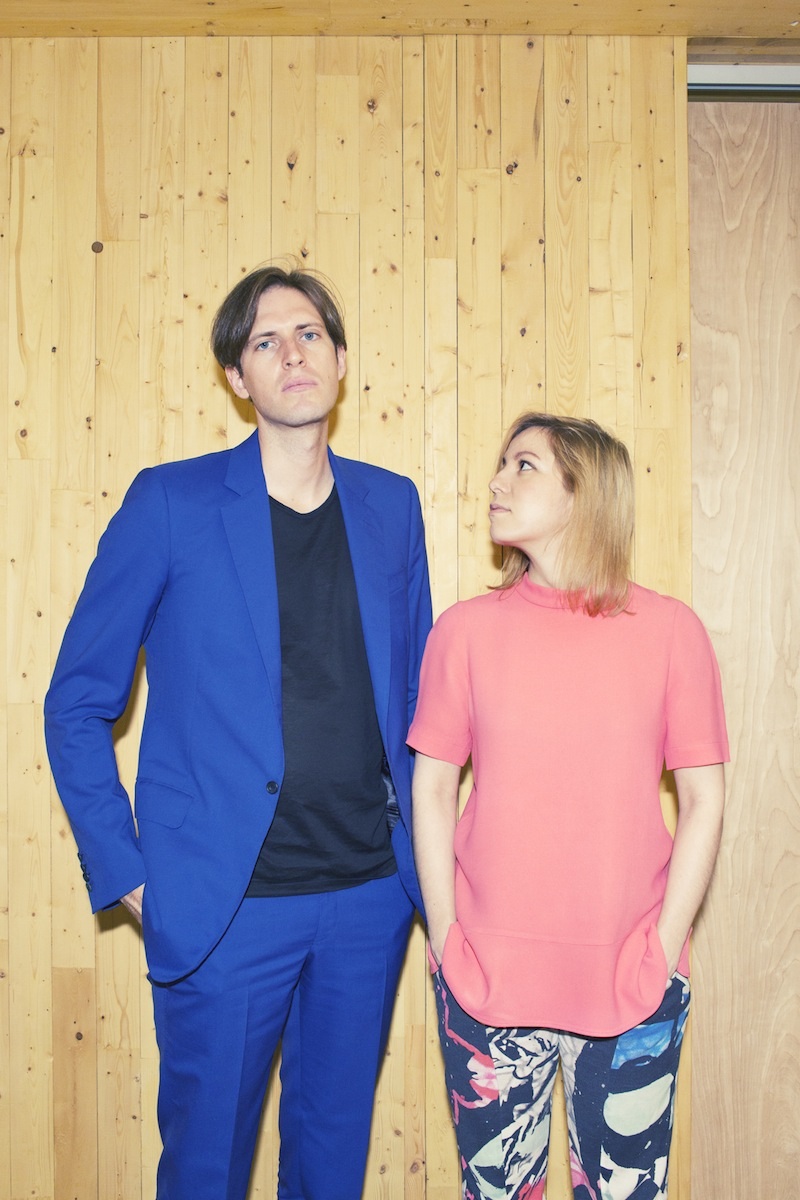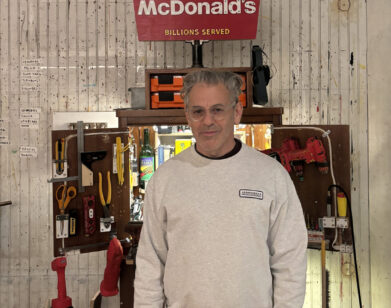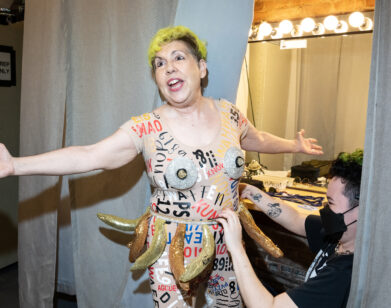The Journal of Michael Nevin and Julia Dippelhofer
For the last 15 years, the journal magazine has reflected New York’s underground art and culture scenes with uncanny insight. Looking at the 34 covers, one can glean the rise and fall of the Dash Snow-era East Village, told through gritty black and white images of subways and street corners; then there’s the ascendance of what could be construed as the first hipsters, with exaggerated moustaches and saucy expressions; and at last the Lara Stones, the Abbey Lee Kershaws, and the Lindsey Wixsons take over as art and fashion lines began to blur. Hopping from iconoclasts to artists to thinkers to designers and more in its pages, the publication has nailed parts of culture just under the radar, capturing moments even as those in the moments weren’t sure of their own significance.
About decade ago, founder Michael Nevin and his partner Julia Dippelhofer spontaneously held an art show to accompany the launch of an issue. That was in the East Village on 6th Street, between Avenue A and Avenue B, in October 2004. They held more shows, and began to include supplements in the journal created independently by exhibited artists. Almost without meaning to, they had a gallery on their hands–one that slowly diverged from the journal. In late 2006, they lost their lease and followed the exodus to Williamsburg, where they amplified blowout block party openings with music performances from the likes of Chairlift, Thurston Moore, and Will Shine. Meanwhile, the space attracted major up-and-coming artists like Joe Bradley, who curated “Peanut Gallery” in 2009-10 featuring friends like Dan Colen, Rita Ackermann, Agathe Snow, and Josh Smith. Today, Nevin and Dippelhofer at last consider theirs a commercial gallery. But with its emblematic history, The Journal Gallery is also a cultural touchstone in itself.
It’s enough to merit its own retrospective–and recently caught the attention of art world maven Adam Lindemann. This summer, he’s organized a survey show, titled “Life,” about The Journal Gallery at Venus Over Manhattan, Lindemann’s own Upper East Side gallery. “Normally galleries are in competition!” explains Lindemann. But the collector and gallerist has given up his space twice before–and the ever-unconventional The Journal Gallery was a perfect fit: “fresh, surprising,” he says. The exhibition highlights artists exhibited in the gallery over its 10 years, like Ackermann, Jeff Elrod, Bradley, Brian Belott, and Dan McCarthy, many of whom were featured in the journal as well. “It’s Bushwick meets Madison Avenue,” says Lindemann of “Life.”
Yet the business of Bushwick–and all its subsidiary art locales–is business as usual to Dippelhofer and Nevin, who met at art school in 1999. It was then that Nevin launched the journal as a snowboarding zine–the first of which were made at a Kinkos with his friends. Dippelhofer was always closely involved. Today they’re a pair so integral to the scene that they seem hardly aware they are in it. Hence, the journal and The Journal Gallery are, as their names suggest, records of Nevin and Dippelhofer’s own experiences.
We met the couple at their new gallery space in Williamsburg, which they’ve been in since October 2012. It is set up like a traditional white cube, and the old zines are stored in boxes.
RACHEL SMALL: You met at art school, at Montserrat College of Art in Massachusetts. In your freshman year, you started the journal as a zine.
MICHAEL NEVIN: I’d just published the first issue together with a couple of friends there. Zine style. Julia and I were both taking the same photography class, and it was a night photography class at the college and we met there. It wasn’t until years later that we worked together, but Julia was always a part of it one way or another. The title of the journal reflected the idea that the magazine was like a personal journal. In the earlier issues I had deep ties to the snowboarding scene and so there was a bit of that mixed in with essentially artists who I went to school with.
SMALL: You basically inherited the space for Issue magazine, where you both interned before it folded, as the first space for the journal.
NEVIN: The space was so huge–it was a whole building in the East Village. We immediately threw the first art exhibition there. It was done without the intention of having a proper gallery; it was just done to have an exhibition. From there it kept rolling. At this point we’ve done around 70 exhibitions, over 10 years.
SMALL: You look exhausted just saying that. So, the first few exhibitions were tied to the magazine.
NEVIN: Yeah. We started doing this thing that we called “the supplement” almost 10 years ago [in 2004]. Often the supplement artists would have the show in the space.
DIPPELHOFER: [Featured artists] didn’t necessarily turn into shows. The first artist we met in New York was Dan McCarthy. Through him we had a relationship with Anton Kern Gallery because we did something with him in a magazine. Then we did a show with David Shrigley who was showing with Anton Kern. So we started to get into the whole “gallery situation” even though it was just project shows. But working with other galleries [allowed us to see] how it all works.
SMALL: It seems that one thing just led to another.
DIPPELHOFER: It was a really organic process. We didn’t have a plan. We actually never wanted to be a gallery, even though we’re still here. We enjoy the energy that the gallery brings in and that instant feedback. At openings in the East Village, we had hundreds of people come. Just to have that energy was so great. That was more important for us, in a sense. It wasn’t the intention to be a gallery–just much later we realized we were kind of good at it.
SMALL: What do you think attracts artists to The Journal Gallery?
NEVIN: Our approach to shows is always a very pure one–solely out of love and admiration of the work. I think that’s how the magazine, even early on, had so many people wanting to participate. I think people sensed that we had a real interest and curiosity.
SMALL: What draws you to a certain idea or person?
NEVIN: We just get this feeling that this person and this person and this person would work well together in one issue of the magazine. Sometimes that’s about throwing a little bit of a loop and not necessarily putting two people doing similar things together, in order to create some kind of tension. We always try to create a push-pull. [For example] featuring artists and then, right after, something with a scientist. When we started doing this, magazines were sort of pigeonholed into art magazines, fashion magazines. We started mixing it all up. I think that’s a more interesting way to approach the project because as individuals we’re not solely interested in art; we’re interested in many things.
SMALL: If you wanted to feature a scientist, how would you explain the journal to him or her?
NEVIN: We’re curious, and quite often [people we approach are] people we want to meet. It’s like an invitation into somebody’s life. So we watched Transcendent Man, this documentary on Ray Kurzweil, who’s this inventor and scientist. And just thought, “Wow, that’s incredible, we have to meet this guy,” which we did. Then we featured him in the magazine.
DIPPELHOFER: I’m not sure they ever really understand why we’re interested in them. Sometimes you don’t need to explain so much. They see a copy of the magazine, and they’re like, “Oh, why would you want me in there?” But they’re happy to do it. Both with the magazine and with the gallery, it’s always a lot about the relationship with the people.
NEVIN: One is example is from when, years ago, my dad’s friend was married to the mother of Ol’ Dirty Bastard from the Wu Tang Clan. After Dirty passed, she kept showing me all of these scrapbooks of things that she kept of his. We got the idea that it would be really interesting to publish these, and then interview her to get her recollection on each thing. They were just incredible things–notes from Mariah Carey, amazing clippings from newspapers. That’s the sort of thing that I think we appreciate putting in the magazine.
SMALL: I feel like because you’re both of hands-on with it, something that personal is very possible. An interview you couldn’t just copy.
NEVIN: That’s both the strength and the weakness of the magazine. We’re two people making all of the editorial decisions.
SMALL: It sounds like the journal and The Journal were first interlocked, then slowly diverged.
NEVIN: [At first] it was very incestuous because purely we didn’t really think of the gallery as a separate entity . As time went on, we started to see the gallery as its own independent organism. Years and years later, here we are as a commercial gallery.
DIPPELHOFER: I think when it happened [making the leap to a commercial gallery], we were in the small space up the street. We never had enough space. The magazine was always our love child; the gallery more happened on its own. But it was very taxing–we did three-week shows, so there were a lot of shows. Then we did music performances in between. Everything was a bigger thing, because it had to do with the magazine. I think we couldn’t it all at the same time and give it justice.
Because of that, the gallery became a more of a considered “gallery situation.” Then collectors became aware and they started travelling here to see the space, and critics started to come and see the exhibitions and so with that, of course, comes a set of responsibilities. At that point, we had never represented artists [that we held shows for] so they continued to be shown at other galleries.
We felt maybe we didn’t just want to be a platform to expose everybody [anymore]. So we started to represent artists and started working with artists more closely. With that in mind, the gallery really became a proper gallery. Then we moved here [to our current location] as that.
SMALL: The commercial side of the art world deals a lot more with collectors, art fairs and things like that, I feel. Was there an adjustment period?
NEVIN: Definitely. We were sort of trying to figure out if we wanted to participate in that realm. To us for a certain period of time, the worst thing was to be involved in “selling out.” It seemed so vulgar. We wanted to publish the magazine and do the shows for fun…
DIPPELHOFER: And for the artists. For fun for us and the artists.
NEVIN: We wanted to present projects that artists wanted to do or exhibitions that artists wanted to do. But then at a certain point, I think when the gallery matured and we grew up a little bit, we realized there was more to it than just selling art. There’s a lot of good that comes out of engaging with collectors and selling. You can do amazing things for artists and you can help build fantastic collections, see works live on in a different context. We said, “Okay, we want to go on and open a bigger space. Take on more ambitious exhibitions and projects, represent artists.” Take the next step and really throw ourselves into all of it. Being on the fence was difficult.
SMALL: You were saying at one point, sort of during your transition period to a more formal gallery, you’d have major openings, with performances. What was the scene like at one of these events? Who was there? Was it wild and crazy? Or people sipping wine, checking out art?
NEVIN: Never that!
DIPPELHOFER: We’ve never served wine once.
SMALL: Really?
DIPPELHOFER: It’s always beer. Not for a particular reason, it just happened that way.
NEVIN: One of the openings in the East Village, I remember… we had hundreds of people there, and a fire truck showed up. And then all of these people climbed onto the fire trucks and were hanging off of them. We had things like this going on. It sort of went on to that space in the East Village to the space here that it small. But we continued doing the same thing [in our new space in Williamsburg], basically in a shoebox. Obviously it was super crowded. All of the exhibitions there had people in the street.
NEVIN: People would come and not able to see anything.
DIPPELHOFER: The police were always around; people got tickets for drinking outside, stuff like that. We had a great landlord who lived right next door, and he was always out with us; that street is not very residential, so we never really had any issues other than the people who drank outside and the police.
It was always a really nice crowd and was kind of funny to watch because, of course, depending on who the artist was or who the artists were, it would change a little bit. But we kind of had a core crowd, always. Even now in this space we didn’t know what to expect when we had the first opening. But it’s funny how it changes over time, and then also how it changes with each separate opening… you never really know what you’re going to get.
SMALL: Going to the Venus Over Manhattan show, how did you guys connect with Adam Lindemann?
DIPPELHOFER: The funny thing is we met Adam a really long time ago, through a friend, Adam Kimmel, who introduced Adam Lindemann to the magazine. There was no talk about the gallery.
NEVIN: Back when we first met Adam, we were more magazine-focused. And then we didn’t run into Adam again for years. We just met him again when he came over to the gallery a year ago [at the current space]. We connected. I think in a way, our galleries sort of adopted a more commercial gallery model. What we came from was a little bit more freeform, and on the fringe of what’s expected of a gallery. I think that’s in a way what Adam’s doing as well. So [we had] this idea of bringing our program, our history, to the Upper East Side; we discussed the idea with him, and his space was just perfect.
DIPPELHOFER: It just so happened that the gallery has been around in one form or another for 10 years. The show [at Venus Over Manhattan] is in the way of the shows we used to do, or what we have done, and just bringing all of the people back in that were involved in one point or another. It’s kind of a nice way to bring everybody together that way.
NEVIN: The show with Adam is like a curated retrospective. It’s not necessarily our history as a whole–it’s just a piece of the gallery’s history, but choosing the artists and artworks that maybe have a certain line.
SMALL: What line is that?
NEVIN: Elaborate on that line? It’s quite vague because it essentially relates to painting and abstract painting, which we’ve shown a lot of. But beyond that, it’s more of a sensibility and approach to making work… and also a spirit. A lot of people who were showing in this exhibition could be considered part of the same group. It’s exciting to put all of these people in the same room, and show them as a group.
SMALL: Now that you both have had years of experience doing this, what attracts you to an artist or a curator, or anyone you’d work with?
NEVIN: We look for people who are interested in pushing something in a new direction, something that makes you feel a tiny bit uncomfortable or somebody that’s sort of surprising. I think we’re looking to stay outside of the comfort zone.
DIPPELHOFER: It’s still the same approach. I think we’ve become a little more pared down, but really we’re looking for a response to a work often that’s coincides with a response to an artist, or an artist’s personality.
SMALL: Over the years, from the beginning versus now, what do you hope people take away from shows here?
NEVIN: The great thing for us is to see things move out of here and take on a life of their own, whether it’s the next exhibition of the artist to seeing their work in another collection to seeing the work written about–seeing it go on to the future.
DIPPELHOFER: That relates to this sense of community we have with the people that we work with. We’ve always tried to to foster [careers] from the start. Of course that shifts and shapes. But I think that’s an important part too–the sense of community and enjoyment. It’s kind of like a family. I can watch myself grow up so much just looking at who was in that show. Good stories and bad stories. It’s just all part of a whole bigger story.
“LIFE” WILL BE UP AT VENUS OVER MANHATTAN AT 980 MADISON AVENUE THROUGH JULY 26.







